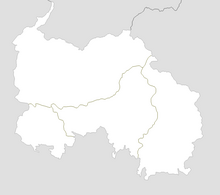South Ossetian Autonomous Region
The South Ossetian Autonomous Region ( Ossetian Хуссар Ирыстоны автономон бӕстӕ / Chussar Irystony avtonomon bæstæ ; Russian Юго-Осетинская автономная область / Yugo-Ossetinskaja awtonomnaja oblast ; Georgian სამხრეთ ოსეთის ავტონომიური ოლქი / Samchret Ossetis awtonomiuri olki ) was a South Ossetia comprehensive management unit and since the 20th April 1922 part of the Georgian SSR .
The capital of the South Ossetian Autonomous Region was Tskhinvali , which was named Staliniri in honor of Josef Stalin from 1936 to 1961 . In 1989 the population was just under 100,000.
On November 10, 1989, the Supreme Soviet of the area decided to found the "South Ossetian Autonomous Soviet Republic". This decision was declared ineffective on November 16 by the Presidium of the Supreme Soviet of the Georgian SSR. Then there were military conflicts. On September 20, 1990, South Ossetia declared itself as the Soviet Democratic Republic independent of the Georgian SSR, which in turn was not recognized and led to the escalation of the conflict.
With the collapse of the Soviet Union and the independence of Georgia in 1991, the South Ossetian Autonomous Region de jure became part of the newly formed Georgian state against popular resistance, but was only partially under Georgian control. The area is now fully controlled by the Republic of South Ossetia .
swell
- ↑ a b Article South Ossetian Autonomous Region in the Great Soviet Encyclopedia (BSE) , 3rd edition 1969–1978 (Russian)
- ↑ Article Tskhinvali in the Great Soviet Encyclopedia (BSE) , 3rd edition 1969–1978 (Russian)
- ^ Chronicle of the events of the Georgian-Ossetian conflict 1988–1994 . RIA Novosti, August 11, 2008 (Russian)
